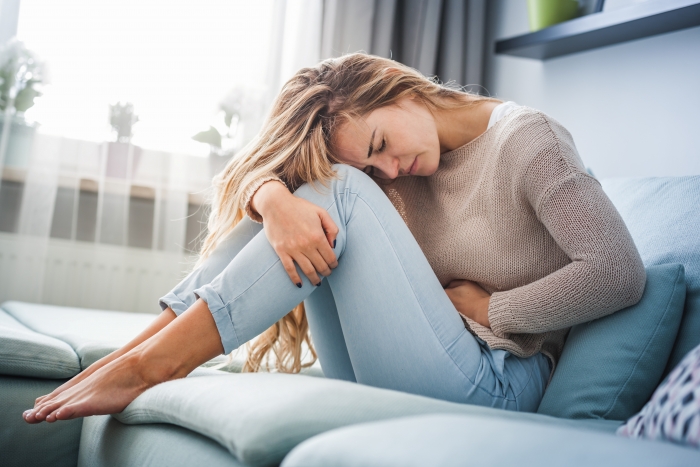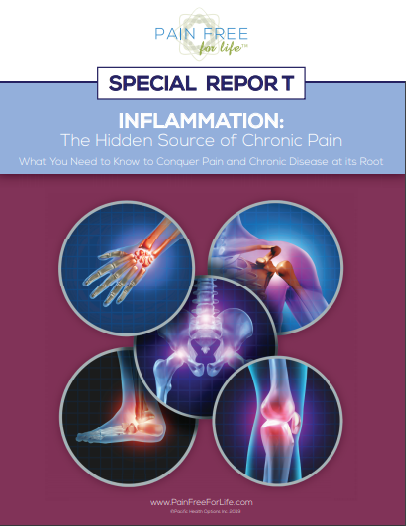
Looking for monthly inflammation and period cramp relief? You’re not alone.
Worldwide, 59% of people who menstruate experience some degree of dysmenorrhea, or pain accompanying the menstrual period. In developed countries, the incidence is often even higher.
But not all period cramps are equal.
For most individuals who menstruate, the pain is mild and can readily be relieved by simple home remedies such as gentle yoga, chamomile tea, or mild heat. But for others, the monthly cycle is a recurring nightmare of wave after wave of crushing pain lasting for hours per day, sometimes for days on end – often (but not always) accompanied by a plethora of other nasty symptoms such as nausea, vomiting, diarrhea, hot and cold flashes, lower back pain, headaches, fainting, and/or severe fatigue.
Such scenarios are more common than most people imagine; some studies estimate that up to one in five menstruating people experience severe pain with their monthly cycle.
Suffering in Silence
Such debilitating pain can interfere significantly with daily life and create economic hardship due to lost work. And because most people – even many people who menstruate – don’t understand the extent of the pain someone with dysmenorrhea suffers, they may view them as slackers using their monthly period as an excuse to loaf around.
Because of this – and also because until recently menstruation was considered a taboo subject in many circles – many people experiencing painful menstruation have historically simply ended up suffering in silence.
But severe menstrual pain is NOT normal, and NO ONE should have to endure this kind of pain and lifestyle disruption for months or years on end. When your monthly cycle comes with crushing pain that takes you out of commission for days each month, it’s time to seek help.
In just a moment, we’ll take a look at some common treatments for severe period pain, along with natural period pain remedies that actually work. But first, let’s explore the origins of period pain – because knowing the cause of a disorder always offers clues to treating it effectively.
What Causes Period Cramps?
Menstrual cramps are contractions of the uterus, the reproductive organ where a fetus grows in its mother’s body. These contractions are triggered by hormones called prostaglandins and are identical to labor pains. (One woman we know reported that she found natural labor to be easier than getting a period – which tells you just how severe menstrual cramps can be!)
Prostaglandins work throughout the menstrual cycle to create slight contractions in the uterus. But during menstruation, these contractions grow stronger. If they become strong enough, muscle contractions can interfere with the blood supply to the uterine muscles – leading to sensations of pain.
Not all prostaglandins are found in the uterus. Different types of prostaglandin occur throughout the body. In addition to regulating muscle contraction, these hormones are an integral part of the body’s healing response – specifically, inflammation. Prostaglandins are a root cause of the inflammation, fever, and pain that triggers the body to send healing agents to a site of injury. This fact provides a key clue to treatment, as we shall see shortly.
Primary vs. Secondary Dysmenorrhea
When period pain occurs by itself, it’s known as primary dysmenorrhea. In some cases, dysmenorrhea occurs as a secondary symptom of another condition affecting the female reproductive organs, such as endometriosis, pelvic inflammatory disease, or uterine fibroids. Doctors refer to such cases as secondary dysmenorrhea. These conditions require a separate approach in addition to direct methods of period pain treatment.
Either way, menstrual pain is no fun. Now that we’ve learned what causes period pains, let’s see what can be done to stop the pain.
How Do Doctors Treat Severe Menstrual Cramps?

If you’ve ever been to a conventional doctor complaining of period pain, you probably were either prescribed anti-inflammatory drugs, hormone treatments, or both. While these both can be effective at resolving pain, both can have unwanted – and often serious – side effects.
For instance, medical consequences of taking ibuprofen – a commonly prescribed drug for menstrual pain relief – in large amounts or over an extended period of time include:
- heart attack
- kidney dysfunction
- gastrointestinal bleeding
- ulcers, and
- liver failure
That’s on top of common side effects such as heartburn, stomach pain, nausea, and gastric upset. When you consider that the average range of childbearing years spans nearly four decades, that’s a significant risk.
Oral contraceptives are also commonly prescribed for menstrual cramps because they reduce the amount of prostaglandins the uterus produces. But the use of contraceptive drugs, too, has its risks. Contraceptive use has been linked to increased blood pressure, liver tumors, cancer, and increased risk of cardiovascular issues such as heart attack, stroke, and deep vein thrombosis. They are also associated with unpleasant symptoms such as nausea, migraine, loss of libido, mood changes, and weight gain. In addition, it can take several cycles before the pain relieving effects start to kick in.
Even if the side effects don’t concern you, both of these conventional types of therapy tend to diminish in efficacy over time. Even if they do work for you at first, there’s no guarantee that in a few years you won’t find yourself back to square one searching for effective resolution of your monthly period pain.
What About Holistic Treatments for Menstrual Pain?
Google “natural menstrual pain remedies” and you will find scores of ideas, ranging from herbal tea to yoga to massage. While some of these solutions can be effective for some people some of the time, most are too gentle to offer effective relief for people who suffer from severe dysmenorrhea.
Many holistic cramp relief options entail small diet changes that may have a long-term effect but rarely a short-term effect on debilitating cramps. Things like fennel, chamomile tea, or cutting out fats may help over time, but they do little to help people in the moment. And when your cramps are so bad that you are screaming into your pillow in pain, you can’t afford to wait.
7 Natural Treatments for Severe Menstrual Cramps That Actually Work
A study conducted by the University of Birmingham and the Birmingham Women’s National Health Service Foundation Trust analyzed clinical evidence on the efficacy of a number of menstrual pain treatments. A few natural treatments were found to be “likely beneficial” in the treatment of menstrual pain, including:
- Acupressure
- Behavioral interventions (relaxation)
- Certain herbal remedies, including toki-shakuyaku-san (an herb used in Chinese medicine)
- Topical heat (about 102˚F)
- Vitamin E and Thiamin supplementation, and
- High-frequency transcutaneous electrical nerve stimulation (TENS)
However, none of these treatments equaled or exceeded ibuprofen for across-the-board effectiveness – and most were described as, essentially, “better than nothing.”
So what’s a person with severe period pain to do? Are you doomed to losing days out of every month to debilitating pain for decades?
Fortunately, we have an alternative solution. One that’s completely natural, has no negative side effects, and which actually does work for nearly every person we’ve worked with to resolve menstrual pain – even severe dysmenorrhea – quickly and effectively.
That solution is microcurrent.
Why Does Microcurrent Work So Well (and So Quickly) to Relieve Severe Menstrual Pain?
Microcurrent is the safest, most effective therapy we are aware of to reduce the inflammation that lies at the root of menstrual pain. It communicates directly with the body’s own network of electrical communication to shut down inflammation fast.
Unlike a TENS device, microcurrent works at frequencies in the exact same range as the body’s own. By running current through conductive pads, or the QiWave pad, into the uterus we can effectively relax the cramping and provide extended relief.
Microcurrent is a direct intervention, so it provides immediate relief for menstrual pain – without interfering with the body’s chemistry or putting you at risk of dangerous side effects. It’s also a long-term solution that doesn’t lose efficacy with time. Our microcurrent machines use body-friendly waveforms and constantly alternate frequencies, making it a solution for pain relief from cramps that does not need to be replaced by other options down the line.
If you’d like a deeper understanding of how microcurrent works in the body to reduce inflammation and relieve pain for good, download our free special report, Inflammation: The Hidden Source of Chronic Pain.

Will Microcurrent Work for Your Period Pain?
If you’ve suffered from severe period cramps for years and tried one “solution” after another only to find yourself doubled over in pain once again, you may be wondering, “this may work for other people, but will it actually work for me? I’ve never found real relief from anything.”
After observing countless patients and customers over the years, we can honestly say that we’ve personally seen this technology help most people willing to give it a real try to regain their life back from menstrual pain.
For some, it works right away. For others, we need to work with them a bit to find a protocol that will work for their body. It’s all about being able to utilize the device in the correct way to deliver the relief and having the discipline to hook it up and turn it on when needed.
We’re available to answer any questions you may have about how to get started with microcurrent for menstrual inflammation and period cramp relief. If you’ve had it with having to put your entire life on hold to deal with debilitating pain for days each month, and are ready to finally say goodbye to menstrual pain for good – without dangerous or unpleasant side effects or having to wait for months for a therapy to kick in – why not give it a try?





